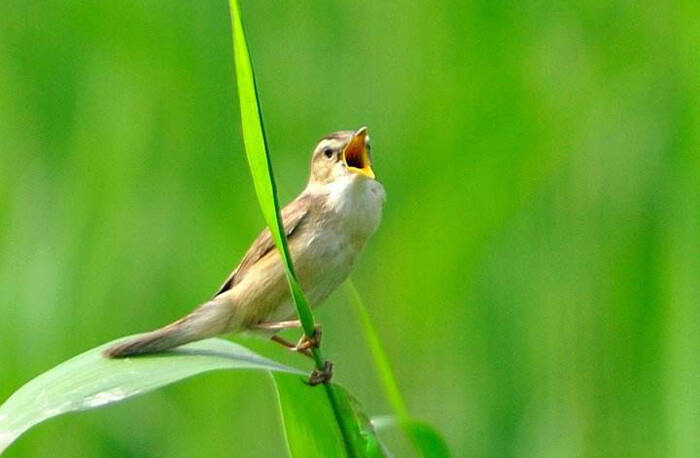Acrocephalus sorghophilus
IUCN
LCBasic Information
Scientific classification
- name:Acrocephalus sorghophilus
- Scientific Name:Speckled Reed Warbler,Acrocephalus sorghophilus
- Outline:Songbird
- Family:Passeriformes Ornithogalidae R.Warbler
Vital signs
- length:12-13cm
- Weight:8-10g
- lifetime:No verification information
Feature
The upper body is ochre brown, with faint vertical lines on the crown and upper back
Distribution and Habitat
Endemic to eastern China. Breeds in northeastern China and winters in the Philippines. Breeds in Liaoning and northeastern Hebei. Migrates to Luzon Island via Hebei, Jiangsu, Hubei and Fujian.
It mainly inhabits reeds and grass near lakes, rivers and other water bodies, as well as rice fields, ponds and coastal reed marshes and grasslands. Breeds in low mountain areas below 800 meters above sea level.
Appearance
Male and female Grevy's Reed Warblers have similar plumage colors. The upper body is ocher brown or ocher yellow-brown, with brown or dark brown fine vertical stripes from the top of the head to the back. The vertical stripes from the top of the head to the back of the neck are very subtle, and the vertical stripes on the back and shoulders are more prominent. The eyebrow lines are yellow, wide, long and prominent, from the base of the mouth to the top of the ear feathers. There is a narrow black lateral crown pattern on the eyebrow lines, the eye lines are dark brown, and the cheeks and ear feathers are ocher yellow. The wing coverts and flight feathers are dark brown, and the feather edges are dark brown and similar to the back. The lower tail coverts and tail feathers are brown, the feather edges are light brown, the tail feathers have browner edges, and some tail feathers have less obvious dark horizontal spots. The skin of the chin and throat of the lower body is yellow, and
Details
The Speckled Reed Warbler is a medium-sized reed warbler with no subspecies.

The Speckled Reed Warbler is a summer migratory bird and a traveling bird in China, and perhaps a winter migratory bird. Every year, it migrates to Hebei, Beijing and other places to breed in late May and early June, and begins to migrate south in late September and early October. It feeds on reed fields in summer, but is seen in millet fields during migration. It often hides in reeds by the river or lake, and sometimes flies to nearby trees. During the breeding season, it often sits on the top of the reeds and branches near the nest and sings loudly. The singing is rich in rhythm and quite pleasant to the ear. It is very alert and often flies to a new place suddenly.
The fine-striped reed warbler mainly feeds on caterpillars, grasshoppers and other insects and insect larvae of Coleoptera, Lepidoptera, Orthoptera, etc., and also eats other invertebrate foods such as locusts, beetles, spiders, etc. During the brooding period, it mainly feeds on mosquitoes, flies, and Lepidoptera larvae, which can eliminate a large number of pests.
The call of the Fine-striped Warbler is a loud, harsh, and incoherent call; it is heavily guttural, mixed with high-pitched cries and low croaks. The calls include a harsh tack and a churr.
The Fine-striped Warbler migrates in late May each year and stays in the breeding grounds for about 80-100 days. Each nest lays 5 eggs, and the incubation period is 13-14 days. Both males and females participate in the brooding, and the brooding period is 11-12 days.
The number of Fine-striped Warbler has declined due to the destruction of the habitat of its wintering grounds. In Candaba, Philippines, almost all the swamps have been destroyed and converted to rice cultivation and fish ponds. Additionally, locals there burn reeds and other native vegetation to encourage livestock to eat new shoots. The banks of Laguna de Bay are being occupied by settlers and factories, so the reed beds are becoming highly fragmented and greatly reduced in area, and at Bukal in Laguna de Bay, most reed beds have been drained for conversion to poultry processing plants. Conversion of wetlands for agriculture in northeast China may also contribute to the decline of this species (2010). The impact of widespread use of pesticides to reduce mosquito and other invertebrate populations may be to remove these species while also significantly reducing the food chain supply for the Slender-striped Reed Warbler. Trapping of birds for food and sale as caged birds is often carried out in areas of reed beds and may seriously affect this species, especially given the likely extremely limited suitable sites that remain within the wintering range.
Listed in the IUCN Red List of Threatened Species (ver 3.1): 2022 - Critically Endangered (CR).
Listed in China's National List of Key Protected Wildlife (February 5, 2021 [6]) at level 2.
Protect wildlife and stop eating game.
Maintaining ecological balance is everyone's responsibility!








